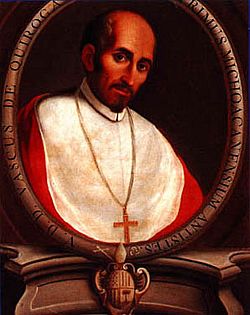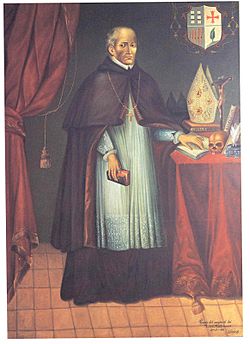Vasco de Quiroga facts for kids
Quick facts for kids
Venerable
Vasco de Quiroga
|
|||||||||||||||||||||||||||||||
|---|---|---|---|---|---|---|---|---|---|---|---|---|---|---|---|---|---|---|---|---|---|---|---|---|---|---|---|---|---|---|---|

Vasco de Quiroga, member of the second Audiencia and first bishop of Michoacán
|
|||||||||||||||||||||||||||||||
| Born |
Vasco de Quiroga
1470 or '78 |
||||||||||||||||||||||||||||||
| Died | 14 March 1565 (aged 86–94) |
||||||||||||||||||||||||||||||
| Burial place | Basílica de Nuestra Señora de la Salud, Pátzcuaro, Michoacán, Mexico | ||||||||||||||||||||||||||||||
| Nationality | Crown of Castile | ||||||||||||||||||||||||||||||
| Alma mater | University of Salamanca | ||||||||||||||||||||||||||||||
| Occupation | Bishop, judge, bureaucrat | ||||||||||||||||||||||||||||||
| Title | Bishop of Michoacán | ||||||||||||||||||||||||||||||
|
|||||||||||||||||||||||||||||||
| Judge of the Real Audiencia of Mexico | |||||||||||||||||||||||||||||||
| In office 10 January 1531 – 16 April 1535 |
|||||||||||||||||||||||||||||||
| President | Sebastián Ramírez de Fuenleal | ||||||||||||||||||||||||||||||
| Preceded by | Nuño de Guzmán of the first Audiencia | ||||||||||||||||||||||||||||||
| Succeeded by | Antonio de Mendoza, Viceroy of New Spain | ||||||||||||||||||||||||||||||
Vasco de Quiroga (born between 1470 and 1478 – died March 14, 1565) was an important figure in early Mexico. He was the first bishop of Michoacán. He also served as a judge, called an oidor, in the second Real Audiencia of Mexico. This was like a high court that governed New Spain (what is now Mexico). He served as a judge from 1531 to 1535.
Vasco de Quiroga was a lawyer and judge before coming to New Spain. He was chosen to be a judge because the first group of judges had problems. As a judge, he worked hard to bring peace to the Michoacán area. This region had been damaged by fighting and unrest. He created special towns called Republicas de Indios for the native people. These towns were based on ideas from Thomas More's book, Utopia.
The goal of these towns was to teach the native people useful skills. They also learned about Christian values and ways of life. He started several of these towns. These included Santa Fé de México near Tacubaya, and Santa Fé de la Laguna near Pátzcuaro. He also founded Santa Fe Del Rio near La Piedad. Vasco de Quiroga is remembered for helping and protecting the native people. He is honored in both America and Spain. He is even respected by the Catholic Church.
Contents
Early Life in Europe
Vasco de Quiroga was born into a noble family in Madrigal de las Altas Torres, Castile, Spain. His family came from a region called Galicia. While his exact birth year is debated, it was likely around 1478.
He studied law and later theology. He probably studied at the University of Salamanca. He worked as a royal lawyer in southern Spain. He also served as a judge in Oran, Algeria, from about 1520 to 1526. After returning to Spain, he worked with the royal court. He had powerful friends, which helped him get a job as a judge in the second Audiencia of New Spain. This group of judges was formed because the first one failed. They started governing in Mexico City in 1531.
Serving as a Judge in New Spain
Quiroga used his own money to start the hospital-town of Santa Fe (Mexico City). This was his first try at building a "Utopia" based on the ideas of Sir Thomas More. He helped many native people become Christians.
He was part of the court that ordered the first Audiencia's leader, Nuño Beltrán de Guzmán, to be sent back to Spain. Quiroga and the other judges also put the previous judges on trial.
In 1533, the Chichimec native people in Michoacán rebelled. Quiroga was sent to that area as an inspector, called a visitador. While serving as a judge, Vasco de Quiroga was greatly influenced by Thomas More's book Utopia, which was published in 1516.
In 1535, the second Audiencia handed over its power. The first viceroy of New Spain, Antonio de Mendoza, took over the government.
Protecting Native People: Información en Derecho
One of Vasco de Quiroga's most important writings is called "Información en Derecho". He wrote it in Mexico in July 1535. This document was a response to the Spanish Crown changing a law. The Crown had previously forbidden the enslavement of native people. But then they allowed it again.
In this long letter, Quiroga, as a lawyer, argued strongly against slavery. He said it was wrong to enslave native people. He believed that the best way to help the native people was to bring them together in special communities. In these communities, they could be taught the Christian faith and a Spanish way of life.
He suggested that these communities should be organized like the ideal society described in Thomas More's Utopia. In these towns, families would be the basic unit. Native leaders would manage groups of families. A Spanish official would be in charge of the whole town. This plan aimed to create peaceful and organized communities for the native population.
Becoming Bishop of Michoacán
In 1536, Vasco de Quiroga was chosen to be the first bishop of the new Michoacán area. The Emperor and the Pope approved this choice. He officially took office in 1538. He stayed in Michoacán, working as a pastor and protector of the native people, for the rest of his life.
As bishop, he moved the main church office from Tzintzuntzán to Pátzcuaro. In Pátzcuaro, he started a cathedral and a school called the Seminary of San Nicolas. He worked to gather the native people into large towns near Lake Pátzcuaro. This area was the center of the Purépecha people. It had been badly damaged by earlier conflicts.
Using Thomas More's Utopia as his guide, he taught the native people religion, crafts, and how to govern themselves. Each town focused on a different craft or industry. People worked about six hours a day and shared equally in what they produced. Quiroga's efforts were very successful. He was greatly loved by the people he served. They called him Tata Vasco, which means Father Vasco.
In 1545, Quiroga traveled to Spain to attend an important meeting called the Council of Trent. He took several native people with him to show them to the Spanish Court. While in Spain, the emperor and the Council of the Indies often asked him for advice on colonial issues.
He returned to New Spain in 1554. On his way back, he stopped in Santo Domingo and got banana plants. He brought these plants to Michoacán. He died in mid-March 1565, in his 90s. His body is buried in the basilica of Pátzcuaro.
His Last Wishes
Vasco de Quiroga wrote his will on January 24, 1565, two months before he died. In his will, he explained how his institutions should continue to run. This included the Colegio de San Nicolas (San Nicolas College). He stated that the descendants of the native people who helped build the College should receive free education there.
He also planned how the money from his Pueblo Hospitals would be used. Some money would pay for monthly church services to remember his parents. Other money would pay the people who managed the Pueblos and the leaders and friars of the College. He left his 626 books to the Colegio de San Nicolas. He also said that any enslaved people he owned should be freed after his death.
His Lasting Legacy
The skills that Vasco de Quiroga taught the Purépecha of the Pátzcuaro region are still used today. Their descendants are known as some of the most skilled craftspeople in Mexico. Tata Vasco trained his students in many different skills.
His idea of each community specializing in a certain craft continues even now. For example, Paracho is famous for making guitars. Tzintzuntzán is known for pottery. Santa Clara makes copper products. And Nurío creates woven wool items.
There is a university named after him in Morelia, Michoacán. A famous composer, Miguel Bernal Jiménez, wrote an opera called Tata Vasco to honor him. It was first performed in Pátzcuaro in 1941. He is also recognized as the founder of the city of Irapuato, Mexico.
Writings
- "Información en derecho del licenciado Quiroga sobre algunas provisiones del Real Consejo de las Indias."
- "Ordenanzas de Santa Fe de Vasco de Quiroga"
- "Testamento del Obispo Vasco de Quiroga"
See also
 In Spanish: Vasco de Quiroga para niños
In Spanish: Vasco de Quiroga para niños


